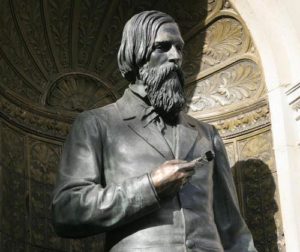Founder of Scientific Ophthalmology – Albrecht Von Graefe
Friedrich Wilhelm Ernst Albrecht Von Graefe (22 May 1828 – 20 July 1870)

Happy Birthday to the founder of Scientific Ophthalmology and father of glaucoma- Von Graefe
He was born in Berlin on 22th May 1828 and was the third son of Carl Ferdinand Von Graefe. His father died when Graefe was only 12. Graefe was an extremely brilliant student from childhood. In 1847, he graduated at the age of 19.
After which, he undertook a trip visiting all the important medical centres, watching mostly eye-work and cultivating some very notable and lasting friendships, particularly with Jaeger in Vienna, Arlt in Prague, Bowman in England and Donders in Holland, with whom he used to correspond freely. Arlt played an important role in directing young Graefe into Ophthalmology. Of them, Arlts and Donders were co-editors in his journal. These travels to the leading European Ophthalmologists of his time usually concluded with mountain climbing in excursions in Switzerland.
Graefe started his practice in 1850 and was the first specialist practising only Ophthalmology, where he treated indigent patients for free. He was regarded as the greatest ophthalmologist of the 19th century. Also, the most versatile Ophthalmologist and a skilful surgeon. In conclusion, modern and scientific ophthalmology owes its beginning to him. In 1862, he married, Anna Countess Kunth. They had three children. Two of them died in infancy.
Contributions:
The ophthalmoscope invented by Helmholtz about the same time thrilled him. He used it to the greatest advantage and demonstrated its place in the diagnosis of general diseases and their relation to fundus conditions. Every branch of ophthalmology- he revelled in – squint, cataract, glaucoma, ulcers, night-blindness and ocular pathology. The years 1951 to 1957 were the most creative years of his practice. Besides giving an accurate description of several fundus conditions, he devised the precursor of the Maddox rods and introduced clinical perimetry (1856).
He made many contributions to ophthalmology being considered the “father of glaucoma” and the Nestor of modern ophthalmology. Von Graefe was the first to introduce excavation of the optic disc in glaucoma (1855), iridectomy in acute glaucoma treatment(1857), central artery occlusion (1859), Neuritis in “brain diseases”(1860), sympathetic ophthalmia (1860), the swelling of the optic disc with increased intracranial pressure (1866), the choroidal changes in tuberculosis together with his pupil Theodor Leber (1868 ), initiated visual field testing and developed the first tonometer.
He founded the first ophthalmological society in the world. His greatest achievement was the foundation of the second journal in Ophthalmology – Archives fur Ophthalmologie, in January 1854. The first volume contained no less than 480 pages of which he contributed 394 pages. His first volume consisted of two major strabismus papers, one concerned with physiology and pathology of oblique muscles and another with cycloductions and versions of eyes in rabbits. Subsequently, took Helmholtz, Arlt and Donders as co-editors.
Two medical eponyms under his name – Von Grefe’s knife and Von Graefe’s sign
Von Graefe’s knife:
It was the most important development in cataract surgery during the 19th century and widely used until the 1970s. The knife features a thin straight blade and a sharp cutting edge. It makes sclero- corneal incisions in cataract surgery. The cataract surgery failure rate decreased from 10% to 5% after the introduction of this knife.
Von Graefe’s sign:
Upper lid lag on the downward rotation of the eye, in other words, it means that the upper eyelid fails to follow the globe while the patient looks down.
Additionally, Graefe was an amazing teacher. Students stood enthralled and began to miss other lectures in favour of his. But he had to resign soon because of the trouble developing in his lungs.
Graefe died of tuberculosis in 1870 at the age of 42. According to Herschberg, Graefe had planned to write a monograph on Strabismus. It’s unfortunate that his untimely death prevented completion of this project, which, undoubtedly would have become a masterpiece. Throughout his short career, Graefe made lasting contributions to most every subspecialty and tirelessly devoted himself to enriching the field of ophthalmology.
Also, read Robert Walter Doyne
In Berlin, his hometown, several Graefe-monuments still exist. One such theatrical monument was at the corner between Schumann- and Luisenstrasse. The initiative for this monument came in 1872, two years after his death. Physicians and ophthalmologists of several countries supported it. The inauguration of the Graefe-monument, a masterpiece of the sculptor Rudolf Siemering, took place in 1882.

If you observe the monument closely, he keeps an ophthalmoscope in his right hand. It was to remind the fact that he was among the first ophthalmologists who regularly used the ophthalmoscope.
Graefe’s thoughts on the importance of sight “So much for the organ which exerts an influence for the nourishment of our mind, for the foundation of our world-view, and for the relation of men among themselves, about whose extent the person in undiminished possession can barely give full account. Speakers have praised it, poets have sung it; but the full value of it is sunk into the mute longings of those who once possessed and lost it”